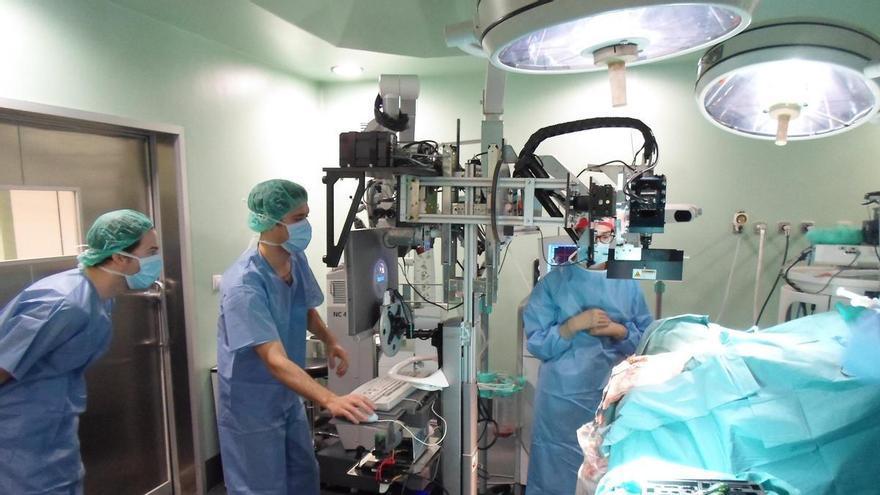ULPGC Leads the Future of Brain Tumor Surgery Technologies

He Institute of Applied Microelectronics (IPMA) belonging University of Las Palmas de Gran Canaria managed to position hyperspectral imaging as one of the most powerful tools for early diagnosis of cancer, especially tumors that are difficult to detect, such as brain tumors. The Helicoid project demonstrated the effectiveness of this technology by applying advanced hyperspectral image classification techniques to detect brain tumors. distinguish between healthy and tumor tissues, allowing the surgeon to perform a more precise and safer surgical extraction. Now they’re taking it one step further technological excellence through European project Stratumwhich starts in February this year, for development new generation of neuronavigatorsbased real-time multimodal data processing—combining hyperspectral imaging with other techniques such as magnetic resonance—in 3D technology using artificial intelligence (AI) algorithms..
Tumor edges
Brain surgeries, especially those aimed at tumor removalthey are serious challenges for neurosurgeons. precise differentiation of critical tissues and tumor boundaries during surgery along with interpretation of large amounts of data coming from various devices are fundamental and often very complex tasks. In this context there arises Project Stratum -continuation of Helicoid-, is funded by €10.7 million from the European Union’s Horizon Europe research and innovation programme.a highly competitive competition in which 170 projects were submitted and only four, including the ULPGC-led project, received funding.
The goal of the project, coordinated by ULPGC Professor Gustavo Marrero Callico, an IUMA researcher, is to develop a new tool to support decision-making during brain tumor surgeries, in which enhances hyperspectral imaging by combining it with MRI, PET, neurosurgical monitoring and even ultrasoundto achieve multimodal system this allows adjust the image in real time taking into account deformations and displacements of the brain at the time of surgerycontributing very accurate information to the surgeon.
Informed, efficient and accurate decisions
Integrating these data sources along with their real-time processing will enable neurosurgeons make informed, effective and accurate decisions during surgical procedures. This will not only maximize the speed of tumor tissue resection, but also it is expected to reduce the risk of neurological deficitsbringing direct benefit to patients.
“With a multimodal imaging system and the use of artificial intelligence, we offer the neurosurgeon a much more accurate model, providing 3D images or even hologram-type images so that they can navigate more easily. The idea is to create what we call new generation of neuronavigators, which will replace the existing ones now, which are very simple and, above all, have a very poor graphical interface,” said Professor Marrero Callico.
Share your knowledge
The methodology adopted to achieve these objectives is based on joint creativityunder the guidance of professor University Institute of Biomedical and Health Research (iUIBS) ULPGC, Ana Wagnerinvolving key stakeholders and end users throughout the development process. This collaboration will ensure that Stratum meets the real needs of healthcare professionals and will make a significant contribution to improving care during brain surgery.
One of the main partners of the Stratum consortium, which heads ULPGC, is the company Canary Foundation Health Research Institute of the Canary Islands (FIISC) belonging to Canarian Health Service (SCS)where the doctor graduated from IUMA-ULPGC and is the main initiator of the project proposal, Himar Fabelowill coordinate collection and management of multimodal project data.
International partners
Along with them, Technical University of Eindhoven (Netherlands), Karolinska University Hospital in Sweden -advisory center Nobel Prizes in Medicine-, He Barcelona Supercomputing Center – which will develop a small supercomputer for clinical use, allowing the provision of information in real time, – SAS Upmem France, University of Pavia Studies (Italy), Polytechnic University of MadridHe University Hospital October 12, Rhineland-Palatinate Technical University of Germanycompany Optomik Spain And European Citizen Science Association of Germany.
It should be noted that Stratum is a project aimed at quickly use your results. “In addition to the research component, this innovative actionsThat is, it has a transfer component to industry,” points out the IUMA researcher and coordinator of the European project. In this sense, the operational activities will be directed by the two industrial partners of the consortium, with Optomic being the main participant in the project. production and marketing of the Stratum tool, which is planned to be carried out by 2030. (two years after completion of the project). “This will place the Spanish industry at the forefront of the production of medical devices for neurosurgery at the international level,” concluded the principal investigator.
Stratum kick-off meetingwhich will take place in the coming days February 26 and 27will gather all members at the institutional headquarters of the ULPGC.
WITH Helicoid Projectgroup IUMA-ULPGKwhich coordinates Gustavo Marrero Callicodemonstrated the effectiveness of the technology with hyperspectral imaging distinguish between healthy and tumor tissue, allowing the surgeon to perform more precise and safer surgical removal after creating a system that detects the presence or absence of cancer in real time. Funded by Europe with 1,100,000 euros, this research culminated on the part of the ULPGC with the receipt of two international patents: one in the USA – Real-time Brain Tumor Detection System using Hyperspectral Images – and another in Japan, transforming IUMA as an international reference in this field. As proof, new Project Stratum, also funded by the EU, this time with 10.7 million euros. | MJH